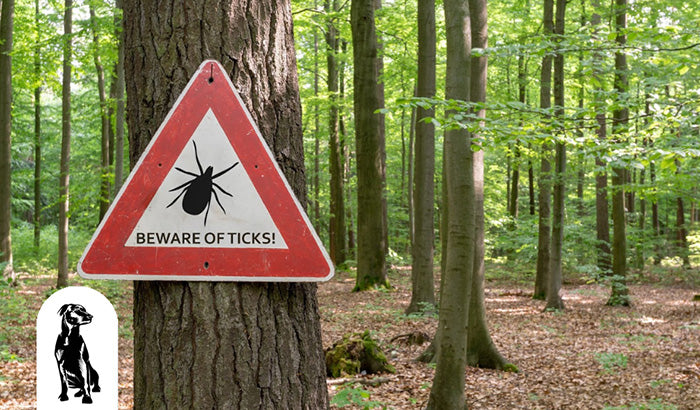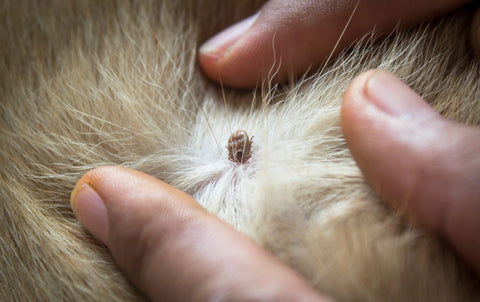
Tick prevention is essential for maintaining your dog's health and happiness. Ticks are dangerous pests, capable of transmitting diseases like Lyme disease, ehrlichiosis, and anaplasmosis, drastically impacting your dog's quality of life. Thus, keeping your dog tick-free is crucial.
Traditional tick prevention methods, such as chemical collars, topical ointments, and oral medications, are effective but have potential drawbacks. Many pet owners worry about these chemicals' side effects on their dogs' health, ranging from skin irritations to severe neurological issues.
Additionally, these methods harm the environment, prompting a shift towards safer, more sustainable solutions.
This shift has fueled interest in natural alternatives like Tickless technology, which is safer for pets and the planet. Throughout this blog, we'll explore how Tickless technology works, its advantages, and why it could be the perfect choice for protecting your furry friend on your next outdoor adventure or a leisurely day at the park.
Understanding ticks and their risks
Ticks are tiny, blood-sucking arachnids that pose significant health risks to dogs and humans. These parasites thrive in grassy, wooded, and leaf-littered areas, eagerly waiting to latch onto passing hosts. Once attached, ticks feed on their host's blood for several hours to days, transmitting dangerous pathogens.
For dogs, the immediate effects of a tick bite range from mild irritation to severe inflammation and infection. However, the real danger lies in the diseases these ticks carry, which include:
- Lyme Disease: Transmitted by deer ticks, this disease can cause fever, joint swelling, lameness, and lethargy in dogs and, if untreated, potentially lead to serious kidney issues.
- Canine Ehrlichiosis: Caused by Ehrlichia bacteria from brown dog ticks and lone star ticks, symptoms include fever, nosebleeds, and swollen limbs.
- Anaplasmosis: Similar to Lyme, this is transmitted by deer and western black-legged ticks. It causes joint pain and high fever.
- Rocky Mountain Spotted Fever: This comes from several tick species and can lead to fever, skin lesions, and occasionally coughing or abdominal pain in dogs.
Understanding these risks is key to protecting your pets. This blog will guide you through various tick prevention methods and how to keep your furry friends safe from these dangerous parasites.

The downsides of chemical tick preventatives
While chemical tick preventatives are effective, they have significant drawbacks for pet health and the environment. Let's explore these concerns and the available methods to help you choose the best protection for your dog.
Common chemical tick prevention methods
Collars
Worn around the neck, these release pesticides that spread over the pet's body, providing long-lasting effectiveness but raising concerns about constant chemical exposure.
Topical treatments
Also known as spot-on treatments, these are applied to specific areas like the base of the neck or along the spine, killing ticks on contact or after they bite.
Oral medications
These monthly pills or chews kill ticks and fleas once they bite and are favored for their convenience and effectiveness.
Potential side effects of chemical preventatives
Skin irritation is common, manifesting as redness, itching, or rashes. Gastrointestinal problems, such as vomiting, diarrhea, or a loss of appetite, are particularly prevalent with oral treatments.
Although rare, neurological issues like seizures or tremors may occur, posing serious health risks. Additionally, some dogs might suffer from severe allergic reactions to the active chemicals, resulting in significant dermatological or systemic symptoms.
Environmental concerns
Chemicals from tick preventatives wash off into waterways during swimming or bathing, harming aquatic life and potentially causing long-term ecological changes. Persistent chemicals might accumulate in the environment, harming non-target species like bees.
Given these concerns, many are turning to safer alternatives like Tickless technology, which offers effective tick prevention without the adverse effects of chemical treatments. This shift protects pets and the planet, paving the way for a healthier approach to tick control.
What is Tickless technology?
This cutting-edge approach uses ultrasonic waves to repel ticks effectively, aligning with the demand for non-toxic pet care products. The inaudible, high-frequency sound waves create a barrier that deters ticks, providing a chemical-free method of protection that’s safe for all dogs — including puppies, seniors, and those with health sensitivities — as well as families with small children.
Tickless technology offers various products tailored to different needs and lifestyles. Tickless collars emit continuous ultrasonic waves, which is ideal for dogs that are frequently outdoors. Ultrasonic tags attach to your dog’s existing collar, providing versatile protection that’s perfect for home and travel.
For added flexibility, portable Tickless devices clip onto a dog’s harness or clothing and are excellent for short trips or specific outdoor activities.
These user-friendly products require minimal maintenance, run on small batteries lasting several months, and are easy to replace, ensuring uninterrupted protection. By opting for Tickless, pet owners not only shield their pets from ticks but also contribute to a healthier environment, minimizing the ecological footprint of their pet care routines.
How to use Tickless effectively
Integrating Tickless technology into your pet care routine is a straightforward process that will dramatically enhance your dog’s protection against ticks. To ensure you get the most out of these innovative products, here’s a detailed guide on using Tickless effectively, along with tips for maximizing its efficacy.
Step-by-step instructions for using Tickless products
Choose the right product
Select a Tickless product that best suits your needs—be it a collar, tag, or portable device. When making your choice, consider your dog’s lifestyle and your typical environment.
Activate the device
Most Tickless products come with a battery that needs activation. This usually involves removing a tab to connect the battery or pressing a button to turn on the device. Ensure that the device is activated before attaching it to your dog.
Secure placement
Attach the Tickless device securely to your dog’s collar or harness. For optimal effectiveness, position it close to the neck or chest. The device should hang freely without being blocked by thick fur or other objects.
Test the device
After attaching the device, observe if your dog exhibits unusual behavior that indicates discomfort or irritation. Then, check for visible signs (like LED lights, if applicable) to ensure the device functions correctly.

Tips for maximizing effectiveness
Optimal placement
For best results, ensure the Tickless device is placed where it has the least obstruction. Avoid tucking it under very thick fur or in areas where it might get covered by your dog’s bedding or clothing.
Regular maintenance
Check the device regularly to ensure it’s clean and free from dirt or debris, which could interfere with the ultrasonic waves. If needed, wipe the device with a dry cloth.
Battery checks
Most Tickless devices use batteries that last several months. To maintain continuous protection, regularly check the battery life and replace it as the manufacturer recommends.
Combine with other preventative measures
While Tickless is effective, combining it with regular checks for ticks after walks in high-risk areas enhances overall protection. Regular grooming and visual inspections help catch any ticks that might not have been repelled.
Educate yourself on tick seasons and high-risk areas
Understanding when ticks are most active and which areas around your home or places you visit are high-risk will help you use Tickless more effectively. Avoiding high-risk areas during peak seasons or taking extra precautions significantly reduces the likelihood of tick infestations.
Plush Paws
At Plush Paws, we understand the importance of your pet's health and your peace of mind. We recommend Tickless products because they embody our commitment to providing top-quality, non-toxic alternatives for pet owners. By choosing Tickless, you're choosing a tick prevention method that leads to a healthier lifestyle for your pet and a more sustainable world.
Tickless is an excellent addition to any pet care toolkit, combining safety, effectiveness, and ease of use. Visit Plush Paws today to explore more about Tickless products and how they benefit your furry friends. Together, let's keep our pets tick-free, happy, and healthy, while also caring for the planet.
